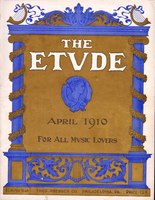"Of the different makes of E string there seems to be no limit, and almost a book could be written about them; but for all solo purposes, quartet and chamber music playing in general, there is nothing to equal a good gut string. Silk strings have their uses in orchestras where the more intimate refinements of tone are lost. Also, since they possess a most distressing durability, they naturally appeal to those to whom even the expense of new strings is an item worthy of consideration. I say distressing durability advisedly, for this type of string will continue to stand long after all pretense of tone has left it. Steel E strings are bright in tone, and, of course, still more durable. They do not lose their tone in the same way that the silk, or prepared silk strings do, and their tone is not at all unpleasant. True there is a slight metallic property in the tone, mostly discernible as the bow leaves the string, but this is not apparent at a distance. At the same time the steel string has two, to my mind, very serious faults. Firstly, there is the danger of being cut, perhaps blinded, when one ultimately breaks, and secondly, there is the great fault that they cut into the bridge too much."—Henry St. George, in The Strad.
Mr. St. George might have added that steel strings are distressingly difficult to tune, and that they wear the hair of the bow smooth much sooner than silk and gut strings. The only possible excuse for their use is in the case of players whose fingers perspire so freely that they find it impossible to use anything else, or for open air playing near the seashore or where the air is excessively damp.



